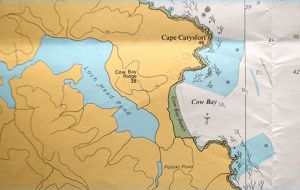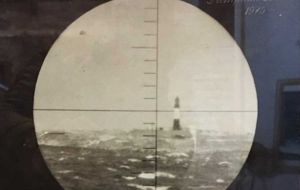MercoPress. South Atlantic News Agency
Falklands coast line surveyed by the Argentine navy during “Operation Cow Beach”
 Submarine Santiago del Estero
Submarine Santiago del Estero Now that the Argentine president Javier Milei has made public a shopping list to equip the armed forces, such as the US manufactured F16 from Denmark for the Air Force, plus tanks, armored vehicles and modern warfare elements such as drones, rockets for the army, and also some surface vessels for the navy, and possibly Scorpane French/Spanish submarines, such as the navies of Brazil and Chile, it is interesting to recall an incident almost sixty years ago when a sea incursion to the Falkland Islands.
In effect at the end of October, beginning November 1966, the Argentine submarine, ARA S 12 Santiago del Estero, was involved in a clandestine coastal survey of Falklands’ beaches, some 40 kilometers north of Stanley, more precisely at Cow Bay, apparently with the intention at some future moment of landing, invading or taking over the Falklands. It was a hush/hush operation for the officers, crew members, commandoes and tactic divers, sworn to secrecy and with the naval intelligence service checking for decades, that in effect not a word of the operation leaked. And so it was for over half a century, when the head of the operation to be later identified as “Cow Beach Operation”, carried out from a sub, Garcia Rabini in a conference at a naval base gave some details of the operation.
The submarine Santiago del Estero after some tasks ordered by the Argentine Geographic Institute was returning from some surveying and exercises in the extreme south of Argentina to its base in Mar del Plata when the head of the tactical amphibious divers division, recently created, officer Garcia Rabini was summoned by the head of the Argentine navy submarines division, Arturo Cesar Ledesma.
Garcia Rubini was then informed by Ledesma, that he was being ordered by decision of the “highest authorities” to prepare together with his three best tactical divers, experienced and of his total confidence, for a very special mission consisting in recovering a land patrol from a beach, at night in extremely cold waters, so divers needed special suits and gear, and they would only carry three days food ration, one day ammo, and had to find their way back to the sub or a waiting vessel; this action with not a word of the mission’s reason or of the whole operation. And so S12 then left with 87 crew members, amphibious commandoes and tactical divers, and several officers for southern Argentina.
At the time in Argentina, only a few months before (June) a military coup under General Juan Carlos Ongania, had deposed elected president Arturo Illia, who was mocked and ridiculed as “the tortoise”, and among his fiercest critics playing the military option, the Timmermans’ father and son, and Mariano Grondona, considered at the time one of a most respected Catholic political analysts. Ongania included in his cabinet as minister of foreign affairs, Nicanor Costa Mendez, (rings a bell).
The sub headed for Peninsula Valdes, close to Puerto Madryn, and during three days trained for the rescue of a stranded patrol on a beach with the help of tactical divers and commandoes with the use of German made kayaks. A few days later they left for the Falklands, immersed during day time and emerging at night until they finally reached Cow Bay. It was only then that details of the mission were revealed and the tactical divers and commandoes on the kayaks headed for the beach, “two kilometers long”, with the purpose of checking on currents, sea slopes, possible obstructions for landing vessels, and the beach itself.
Orders were strict, “in case of contact with locals, police or military from the Islands, they were to argue that they were in Argentine territory and were Argentine citizens. No appeal to weapons, except extreme case and in self-defense. Likewise no damage to private property and ensure that no tracks or signs of the incursion were left…”
However some sea mammal, and quite big one, did give the incursion party a big scare when he/she snorted after almost stepped on, but the biggest challenge was when they came across in the middle of the night of a local farm hand, who detected the group. He was immediately captured and the captain of the submarine, Horacio Gonzalez Llanos, as the highest ranking officer, was immediately informed and asked for instructions to follow. The captain a very much respected officer and with natural leadership conditions, asked about the condition of the prisoner, what was he doing in the middle of the night in an empty beach, the reply was that in effect he was quite a bit intoxicated, presumably lost in the middle of the night. The captain then suggested “come fetch a bottle and let him have a good, good night hangover”, and apparently that is what they did with the farm hand. He was forced to drink a whole bottle of whisky and left to sleep….and to tell Islanders he had met foreign, probably Argentines in diving suits…if you believed him.
The second night all the objectives of the mission and surveying were completed successfully according to Garcia Rubini, including the treacherous currents at Cow Bay, which limited access for the surfaced submarine. Back in Mar del Plata, submarine captain Gonzalez Llanos took a full report of the topographic and hydrographic surveys and accomplishments to Buenos Aires, but that was allegedly the end of the story, be it not for the naval service checking no leaks on the operation came to light. It was also found out later that the operation had a planned back up, several fighter aircrafts ready to take off in Rio Gallegos and a navy’s “fishing vessel,” out in the high seas, but not much more than that was revealed.
Garcia Rubini also recalls the envelope with the written order from then de facto president General Ongania and foreign minister Nicanor Costa Mendez and Commander of the Navy ordering to activate the “Cow Beach Operation”. The order was presented in a simple white sheet, no headlines or seals, with simply scribbled initials.
As a matter of curiosity it is worth mentioning that the second in command of the Santiago del Estero when the operation was none other than young Officer Juan Jose Lombardo, who in 1982 as Rear Admiral was responsible for the logistics of the Argentine invasion in April of the Falkland Islands, which did not take place at Cow Bay.
Likewise back in 1966 October and November were complicated months for the Falkland Islands. In effect a group of young Argentine nationalists in what was called “Operation Condor” high jacked an Aerolineas Argentinas DC4 heading for Rio Gallegos and had it land in Stanley’s racecourse. Armed with some weapons they planted a few Argentine flags, claiming Argentine territory and expecting the people “thankful” to be liberated. The Royal Police, FIDF and locals surrounded the aircraft, and following some negotiations with the mediation of the Falklands Catholic priest, the whole incident was over. The hijackers were sent back to Argentina with the understanding they would be sentenced and locked, and the aircraft later recovered.






Top Comments
Disclaimer & comment rulesCommenting for this story is now closed.
If you have a Facebook account, become a fan and comment on our Facebook Page!